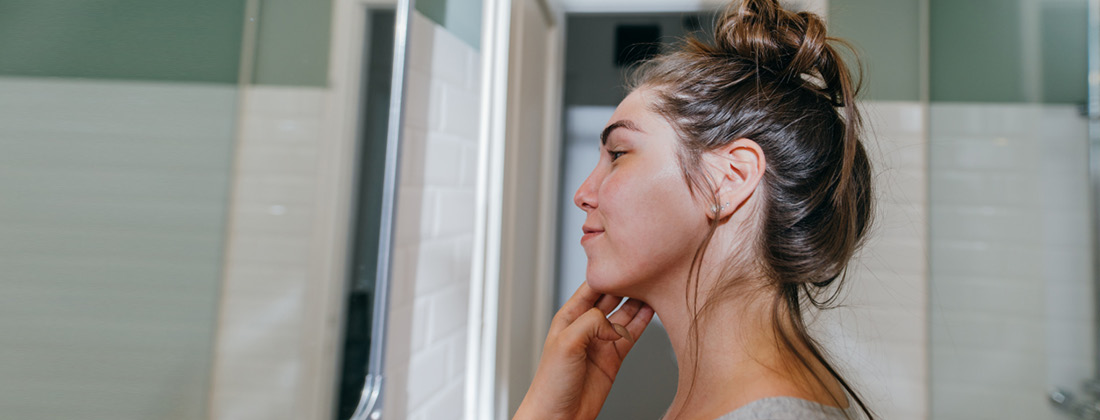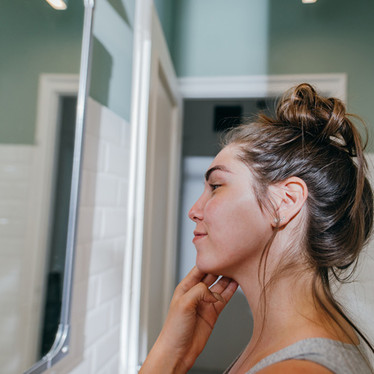
Teenage years are an intense time already, and dealing with acne can just add extra stress! Around 85% of teens will experience problem skin or pimples. While they commonly appear on the face, they can also pop up on the back and chest. Rest assured, we’ve got plenty of tips, tricks and natural products to support clear skin.
More than just skin deep
Teen years are a stage of life where body image and appearance start to hold more importance, so it’s ironic that this is the time acne can pop up. Pimples, zits, pustules, blemishes, whatever the name, acne is more than just skin deep. It’s not just physical, problem skin impacts on emotional wellbeing too. Self-confidence decreases, body image is affected, and overall mood can take a dive. It can be heart-rending for a parent to watch their teens go through this, and in fact, it’s often the mental and emotional impact that prompts people into action.
So what’s the solution? Identifying factors that lead to breakouts in the first place can help when you’re going for a natural approach.
Story of a pimple
Lots of factors are at play when a pimple forms. Excess sebum and dead skin cells can block pores and when bacteria and cytokines (special proteins that regulate inflammatory responses in the body) become involved, a pimple will rear is ugly head.
- Sebum
Sebum is an oily, thick substance secreted by our pores. Excess sebum can lead to pore blockages, so those with oily skin types with more sebum are more inclined to pimples.
- Skin debris
As old skin cells are sloughed off, this skin debris can cause pore blockages too.
- Congestion
These blockages lead to blocked pores or comedones - you’ll hear this referred to as congestion. If no bacteria or cytokine response occurs, they remain as blackheads and whiteheads, i.e. fairly tame and they don’t progress into pimples.
- Bacteria
P. acnes are bacteria that form part of our normal flora, (meaning they live on our skin surface all the time) and can become involved with blocked pores. This recruits cytokines and an immune response.
- Cytokines
Cytokines are signalling chemicals that queue the redness, swelling, inflammation and pus we see in acne. So, it’s important to have cytokine balance.
- Hormones
Teenage years mean hormonal surges, which stimulate extra sebum flow. This can lead to blockages and pimples. Androgen hormones such as testosterone are usually the culprit, and while they are known as ‘male hormones’, they affect all genders. Women can often notice cyclical changes in their skin, breaking out before their period thanks to the rise and fall of certain hormones.
Types of acne
- Comedones
Congestion leads open comedones (blackheads) and closed comedones (whiteheads) and whiteheads which may not progress further. They’re mainly small white raised bumps (whiteheads) or darker less raised blockages (blackheads). These plugs of sebum and skin debris typically appear in oily T-zone areas.
- Pustules & Papules
This is the next level after congestion. When bacteria (P. acnes) and cytokines come into play, papules (small red bumps) and pustules (bumps with pus) can occur. The redness and swelling are physical evidence of a cytokine response happening.
- Cysts
Cystic type acne is larger and affects the skins deeper layers. To the sufferer they often feel bigger and more painful than they look, so they’re sometimes referred to as ‘blind pimples’. Because they’re so deep, scarring can be a problem here.
To squeeze or not to squeeze?
Squeezing can introduce more bacteria to the area, increasing the risk of infection and scarring. Ideally, resist the urge to purge the pustule. Popping pimples can actually trigger a pleasure response. It activates reward centres in our brains which can make us want to keep doing it - this explains why some people just love popping zits, as it gives them a dopamine hit.
Natural vs Nasties
With problem skin it’s important to use natural skincare, that can allow the skin’s natural balance to occur. Some ingredients in skincare has beenlinked with skin irritation, cell damage and even hormone disruption and because acne is hormonally influenced, we need to steer clear of these. Using hormone disrupting ingredients could lead to more problems. With our Ethical by Nature Promise, all of our skincare is carefully checked by our Naturopaths to ensure it delivers on Aotearoa’s leading ethical, ingredient and environmental standards. If it’s made the grade, you can be sure it’s a kinder choice for both you and our planet. What's more, our Ethical by Nature Promise takes the worry out of choosing natural acne and pimple treatment skincare.
Cleansing is key
Cleansing morning and night removes excess sebum and skin debris. This helps prevent pore blockages which might develop into pimples. Over-cleansing can cause irritation so it’s best to stick to cleansing morning, night and after exercise.
Especially designed for women and teens, Oxygen 2 in 1 Cleanser for Women & Teens produces a natural foam, in combination with natural superfine pumice and bentonite beads which act as physical exfoliants. Formulated with natural antibacterial and healing ingredients like NZ Hops, this is a great choice for sensitive skin.
Ethique In Your Face Cleanser is a cleansing bar that has kaolin, a naturally absorbent clay to soak up excess sebum from pore surfaces making it great for acne and problem skin. There’s no plastic bottle either, so it’s lighter on the environment. Another plus? Bars tend to go further than bottled products, so it’s lighter on your wallet too. Wet the bar and rub your hands over it to create a gentle lather.
For congested skin you can’t go past exfoliating aids like this PEARLBAR Charcoal Konjac Sponge to slough off dead skin and get rid of pore blocking gunk. This physical exfoliator is gentle enough to be used daily to keep skin clear and refreshed. As it encourages circulation, it’s great for cell turnover and healing. Infused with detoxifying charcoal, it works fantastically for blackheads and whiteheads – just take care to avoid areas with active pustules to prevent spreading bacteria.
If you’re looking for all-in-one kit this Weleda Love Naturally Clear Face Care Set is it. For deep pore cleansing the Blemished Skin Purifying Gel Cleanser gets rid of that greasy skin feeling, leaving it fresh and clean. Weleda Blemished Skin Refining Lotion leaves skin with a matt finish and reduces the appearance of redness, while Weleda Blemished Skin SOS Spot Treatment has soothing botanicals that work to calm any nasty spots – it can be worn under make-up too. If you have breakouts that cause physical discomfort, go for this kit. Botanicals like Willow have antibacterial action and reduce redness around breakouts. Weleda products are NATRUE certified, that means they have super high standards on what qualifies as natural skincare – no greenwashing here.
Getting enough sleep?
Aim for 7-8 hours per night - research shows it keeps cytokines in check. Getting enough sleep will dial down redness and breakouts. When we sleep, our skin goes into maintenance mode. So, it makes sense to use a targeted overnight serum. New Logic Acne Overnight Serum works on breakouts while you’re asleep. Antibacterial Manuka Honey and NZ Native Kawakawa work on blemishes while Aloe vera soothes and provides water-based hydration to help prevent dryness too. Glycolic acid encourages exfoliation to prevent pore-blocking debris from getting trapped and causing congestion. A proud Kiwi brand, the New Logic range is made right here in NZ. Their breakthrough ingredient- Fibraspect300™ is a patented peptide for sustained absorption, allowing the actives to work for longer. It won’t strip the skin of natural oils either, which are important for the healing process and for the balance of oil in oily-prone skin.
What about diet?
Making small adjustments can help:
Fabulous fibre
- Fibre moves through the bowel, giving it an internal sweep. This keeps the bowel lining healthy – important because a healthy bowel lining keeps cytokines in balance. Fibre also aids in toxin removal.
Fibre-rich foods
- Fruit and veges, especially beans, pumpkin, potatoes with skin, berries and wholegrains, especially quinoa, rice, oats and rye.
- BioBalance Bowel Balance supports a healthy bowel lining which has a flow on effect for normal cytokine balance. It has bowel loving-botanicals, fibre and prebiotic fibres. This is great for anyone who may have a sluggish bowel and wants support for bowel comfort and a clear complexion, which sometimes go hand in hand.
3 reasons to up your Omegas
- Getting enough Omega-3 is key for keeping cytokines in balance, to keep skin clear
- Studies also show Omega-3 balances sebum production – to support clear pores
- Omega-3 helps support healthy hormone levels – especially important if your pimples appear to be hormonally linked.
Omega-3 rich foods include:
- Oily fish - salmon, tuna, and sardines
- Nuts - almonds, walnuts, brazil and pistachios
- Seeds - sunflower, pumpkin, chia, hemp and flaxseed
Looking for an easy way to up your Omega-3 intake? Nordic Naturals Arctic Cod Liver Oil great for this, plus it provides extra vitamin D and vitamin A, both of which are important for healthy skin. Vitamin A can support oiliness and congestion.
For internal management of problem skin, Radiance Clear Skin capsules help support healthy hormone balance of androgen hormones to balance sebum production. These capsules have detox supporting herbs plus skin nurturing vitamins and minerals for clear, calm and balanced skin.
For healthy skin healing Clinicians Zinc Oral Drops can help support the repair and regeneration of skin cells, excellent for people worried about scarring. Zinc is also important for healthy immune function and androgen hormone balance for a blemish free complexion.
Use natural options to support breakout-free skin. Having a healthy, clear complexion means less worries - you’ll be ready to face the world, blemish-free.
Always read the label and use as directed. Vitamins are supplementary to a balanced diet.

